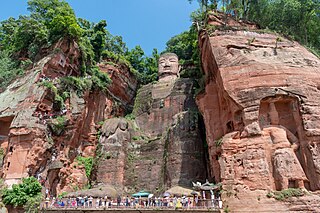
Sichuan is a province in Southwest China occupying most of the Sichuan Basin and the easternmost part of the Tibetan Plateau between the Jinsha River on the west, the Daba Mountains in the north and the Yungui Plateau to the south. Sichuan's capital city is Chengdu. The population of Sichuan stands at 83 million. Sichuan neighbors are Qinghai to the northwest, Gansu to the north, Shaanxi to the northeast, Chongqing to the east, Guizhou to the southeast, Yunnan to the south, and the Tibet Autonomous Region to the west.

The Three Gorges are three adjacent and sequential gorges along the middle reaches of the Yangtze River path, in the hinterland of the People's Republic of China. With a subtropical monsoon climate, they are known for their scenery.

Chongqing, alternately romanized as Chungking, is one of the four direct-administered municipalities of the People's Republic of China (PRC). Geographically, Chongqing is strategically positioned as a gateway to China's west, a key connection in the Yangtze River Economic Belt, and a strategic base for China's Belt and Road Initiative.
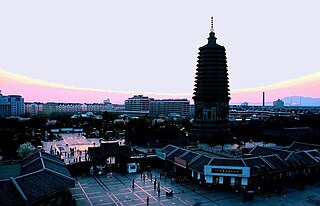
Jinzhou, formerly Chinchow, is a coastal prefecture-level city in central-west Liaoning province, China. It is a geographically strategic city located in the Liaoxi Corridor, which connects most of the land transports between North China and Northeast China, and is the economic center of western Liaoning. Located on the northern shore of Liaodong Bay, Jinzhou encompasses a coastline of 97.7 km (60.7 mi), with the Port of Jinzhou being China's northernmost seaport.

The Wudang Mountains are a mountain range in the northwestern part of Hubei, China. They are home to a famous complex of Taoist temples and monasteries associated with the Lord of the North, Xuantian Shangdi. The Wudang Mountains are renowned for the practice of Tai chi and Taoism as the Taoist counterpart to the Shaolin Monastery, which is affiliated with Chinese Chán Buddhism. The Wudang Mountains are one of the "Four Sacred Mountains of Taoism" in China, an important destination for Taoist pilgrimages. The monasteries such as the Wudang Garden were made a UNESCO World Heritage Site in 1994 because of their religious significance and architectural achievement.
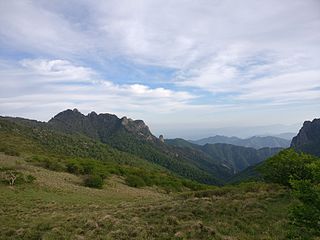
The Qinling or Qin Mountains, formerly known as the Nanshan, are a major east–west mountain range in southern Shaanxi Province, China. The mountains mark the divide between the drainage basins of the Yangtze and Yellow River systems, providing a natural boundary between North and South China and support a huge variety of plant and wildlife, some of which is found nowhere else on earth.

The Dazu Rock Carvings are a series of Chinese religious sculptures and carvings and UNESCO World Heritage Site located in Dazu District, Chongqing, China. The carvings date back as far as the 7th century AD, depicting and influenced by Buddhist, Confucian and Taoist beliefs. Some are in rock-cut cave shrines, in the usual Chinese Buddhist style, but many others are rock reliefs carved into the open rock faces. Listed as a World Heritage Site in 1999, the Dazu Rock Carvings are made up of 75 protected sites containing some 50,000 statues, with over 100,000 Chinese characters forming inscriptions and epigraphs. The sites are located in Chongqing Municipality within the steep hillsides throughout Dazu District, located about 165 kilometers west of the urban area of Chongqing. The highlights of the rock grotto are found on Mount Baoding and Mount Beishan.

The Sichuan Basin, formerly transliterated as the Szechwan Basin, sometimes called the Red Basin, is a lowland region in southwestern China. It is surrounded by mountains on all sides and is drained by the upper Yangtze River and its tributaries. The basin is anchored by Chengdu, the capital of Sichuan province, in the west, and the direct-administered municipality of Chongqing in the east. Due to its relative flatness and fertile soils, it is able to support a population of more than 100 million. In addition to being a dominant geographical feature of the region, the Sichuan Basin also constitutes a cultural sphere that is distinguished by its own unique customs, cuisine and dialects. It is famous for its rice cultivation and is often considered the breadbasket of China. In the 21st century its industrial base is expanding with growth in the high-tech, aerospace, and petroleum industries.

Ciqikou is a Subdistrict in the Shapingba District of Chongqing Municipality, People's Republic of China. It was originally called Longyin Town and was also known as Little Chongqing.
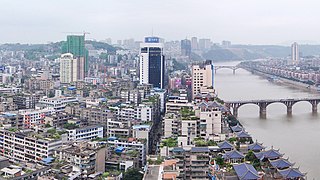
Luzhou (simplified Chinese: 泸州; traditional Chinese: 瀘州; pinyin: Lúzhōu; Sichuanese Pinyin: Nu2zou1; Luzhou dialect: ), formerly transliterated as Lu-chou or Luchow, is a prefecture-level city located in the southeast of Sichuan Province, China. The city, named Jiangyang until the Southern and Northern Dynasties, is known as the "Liquor City" (酒城). Situated at the confluence of the Tuo River and the Yangtze River, Luzhou is the largest port in both size and output in Sichuan province since Chongqing was separated from Sichuan province in 1997. As of the 2020 Chinese census, its population was 4,254,149 inhabitants whom 1,241,273 lived in the built-up (or metro) area made of Jiangyang and Longmatan districts, as Naxi district is not conurbated yet. Luzhou, which borders Yunnan, Guizhou and Chongqing, is the only geographic junction of the four provinces, and was therefore the logical place for a port in ancient China. After the PRC was founded in 1949, Luzhou became the capital of southern Sichuan province. In 1983, Luzhou was approved as a prefecture-level city administratively.

Guang'an is a prefecture-level city in eastern Sichuan province. It is most famous as the birthplace of China's former paramount leader Deng Xiaoping. Guang'an lies between the hills of central Sichuan and the gorges area of the east. Guang'an is the only "Sichuan Chongqing Cooperation Demonstration Zone" in Sichuan and the nearest prefecture level city from the main city of Chongqing. It has been incorporated into the 1 hour economic circle of Chongqing. Because of its strategic location, it is called the "Gateway to Eastern Sichuan". Its population, as of the 2020 census, was 3,254,883, of whom 976,370 lived in the built-up area made up of 2 urban districts.
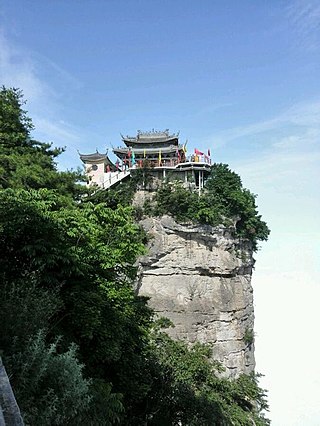
Longnan is a prefecture-level city in the southeast of Gansu province in China. It borders Sichuan on its south and Shaanxi on its east. As of the 2020 Chinese census, the population of the prefecture-level city was 2,855,555.

The Dabie Mountains are a major mountain range located in central China. Running northwest-to-southeast, they form the main watershed between the Huai and Yangtze rivers. The range also marks the boundary between Hubei Province and its neighbors of Henan and Anhui. During the late 1920s and early 1930s, the Dabie Mountains were a stronghold of the Chinese Communist Party and the location of the Eyuwan Soviet.

Nan'an District, is one of the six central districts of Chongqing municipality, China. It covers an area of 262.43 km2, with 44 km2 covered with forests and woods. It has an estimated population of 891,000 in late 2017.
Nanshan, is a common place name in China and adjacent areas:

Hejiang is a county in the southeast of Sichuan Province, China, bordering Guizhou province to the south and Chongqing Municipality to the north and northeast. It is under the administration of Luzhou city.

The Daba Mountains, also known by their Chinese name as the Dabashan, are a mountain range in Central China between the watersheds of the Yellow and Yangtze Rivers. Part of the larger Qinling mountain range, it cuts through four provinces: Sichuan, Chongqing, Shaanxi, and Hubei. It is about 1,000 kilometers (620 mi) long.

Pipa Mountain Park is a major urban park in the city of Chongqing. With an elevation of 345 meters, this park is the highest point of the Yuzhong District of Chongqing. The park used to be a private garden to Wang Lingji, the former KMT governor of Sichuan Province during Republic of China period. In 1955, the garden started to open to public as an urban park. On the top of Pipa Mountain, there is a tall pagoda called Twin River Pagoda, with views of Yangtze River to the south and Jialing River to the north.
Single Tree Vista, also known as Yikeshu Vista or Yikeshu Overlook, is a popular overlook park and tower located in the Nan'an District of Chongqing in Southwest China. It is known as one of the best places to see a panorama of the urban area of central Chongqing, especially the skyline of Yuzhong District, Yangtze River, Jialing River as well as a night view of the city.
Twelve Views of Bayu are popular scenic views in and around the city of Chongqing, China. Ba and Yu are old names of Chongqing in Imperial times. Influenced by Eight Views of Xiaoxiang in Hunan Province, people in Chongqing listed their own most beloved views during the reign of the Tianshun Emperor of the Ming dynasty. Scenic views in the list changed throughout the history. Some scenic views appeared in earlier lists no longer exist in modern days due to the change of physical geography, landscapes and land-uses.
















